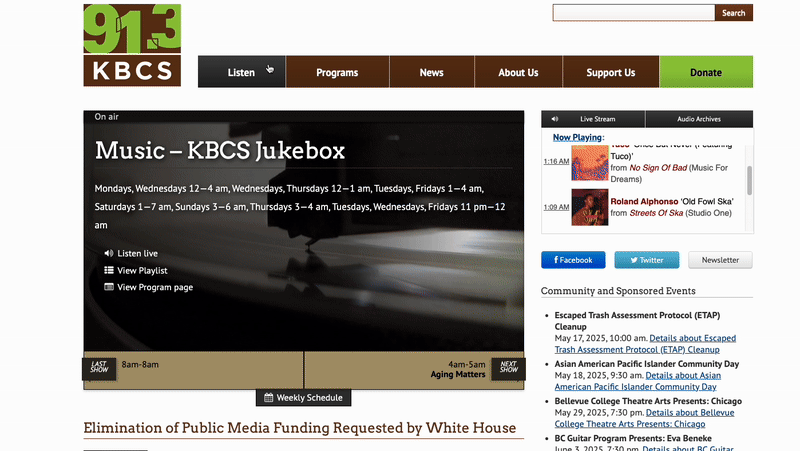
MY ROLE
Product Designer
Information Architect
UX Researcher
DURATION
The Problem
10 Weeks
TEAM
CONTEXT
KBCS FM’s website struggled with confusing navigation, cluttered content, and poor accessibility, making it difficult for users, especially older listeners, to discover programs, donate, or engage with the station’s community-driven offerings.
The Outcome
A redesigned website with simplified navigation, improved content hierarchy, and accessible design that makes listening, donating, and exploring programs easy and intuitive, while staying true to KBCS’s community-first identity.
1 Designer
1 Engineer
1 Manager
RESEARCH AND DISCOVERY
Identifying the Existing Issues
I started by understanding why users struggled with the current KBCS website, uncovering usability gaps, navigation pain points, and barriers to engagement.
METHODS
DISCOVERY
Overwhelming and Hard to Navigate
The site’s dense layout and lack of visual hierarchy made scanning difficult, especially for older audiences who needed more clarity and simplicity.
Understanding the Stakeholder Needs
KEY TAKEAWAYS
SIMPLIFYING THE NAVIGATION
Poor Information Architecture
62% of the usability study participants failed to locate program archives due to poor information architecture (through the survey, it was found that users primarily visit the website for program archives).
Donation Flow Felt Untrustworthy and Unclear
The donation process lacked visibility, clear messaging, and trust signals. Users felt unsure whether their contributions were secure or impactful, leading to hesitation and drop-off.
Beyond user frustrations, it was essential to understand what KBCS as an organization wanted to achieve through this redesign, balancing community impact with operational goals. I conducted a workshop with the stakeholders to understand the business goals and priorities.
I conducted a card sorting exercise to understand how KBCS listeners naturally grouped and prioritized content. This helped me redesign the site’s information architecture, making essential actions like listening, donating, and exploring programs easier to find and navigate intuitively.
DESIGN
INTUITIVE AND SIMPLIFIED NAV BAR
Wireframing to Explore Ideas
I started with low-to-mid fidelity wireframes to map out core user flows, focusing on simplifying navigation and improving content visibility. These quick sketches helped visualize how users would discover programs, access live streams, and donate, keeping accessibility top of mind from the start.
Iterating and Validating Through Feedback
I created wireframes and mid-fidelity prototypes to explore layout improvements, focusing on simplifying navigation and clarifying the donation flow. Through stakeholder feedback and usability testing with KBCS’s primary audience, I identified key friction points in menus, CTAs, and mobile usability. These insights guided refinements in layout, labeling, and interactions to ensure a clear and trustworthy user experience.
Finalizing the Key Design Decisions
The iterative process led to several critical design decisions.
Users struggled to find essential actions like listening to programs or donating. The card sort informed a cleaner Information Architecture, reducing menu clutter and surfacing priority actions like Programs, Donate, and Live Stream in the top navigation. As a result, users could now navigate intuitively without hunting through dense menus.
A DONATION FLOW THAT BUILDS TRUST
The original donation page looked unreliable and disconnected, which discouraged contributions. I redesigned the flow to emphasize transparency and emotional connection, introducing clear messaging like “Donate Now to Support Local Voices”, visible nonprofit trust signals, and measurable impact. These changes made donating feel safe, meaningful, and aligned with KBCS’s community values.
DECLUTTERING THE EXPERIENCE AND SURFACING KEY ACTIONS
The original KBCS website was cluttered and hid important actions behind confusing menus. I simplified the layout with a clear hierarchy and more white space, while surfacing key sections like Archives, Programs, and Donate directly on the homepage for easier access and better usability.











